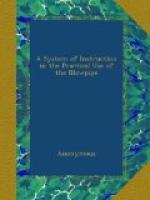Behavior with Borax on Platinum wire
in the oxidizing flame.
No reaction.
in the reducing flame.
No reaction.
Behavior with Mic. Salt on Platinum wire
in the oxidizing flame.
No reaction.
in the reducing flame.
No reaction.
* * * * *
34. Tellurous Acid, TeO^{2}.
Behavior with Borax on Platinum wire
in the oxidizing flame.
Dissolves to a
clear colorless glass which, when treated on
charcoal, becomes
grey and dull from particles of reduced
tellurium.
in the reducing flame.
As in the oxidizing flame.
Behavior with Mic. Salt on Platinum wire
in the oxidizing flame.
As with borax.
in the reducing flame.
As with borax.
* * * * *
7. EXAMINATIONS WITH CARBONATE OF SODA.
The carbonate of soda is pulverized and then kneaded to a paste with water; the substance to be examined, in fine powder, is also mixed with it. A small portion of this paste is placed on the charcoal, and gradually heated until the moisture is expelled, when the heat is brought to the fusion of the bead, or as high as it can be raised. Several phenomena will take place, which must be closely observed. Notice whether the substance fuses with the bead, and if so, whether there is intumescence or not. Or, whether the substance undergoes reduction; or, whether neither of these reactions takes place, and, on the contrary, the soda sinks into the charcoal, leaving the substance intact upon its surface. If intumescence takes place, the presence of either tartaric acid, molybdic acid, silicic, or tungstic acid, is indicated. The silicic acid will fuse into a bead, which becomes clear when it is cold. Titanic acid will fuse into the bead, but may be easily distinguished from the silicic acid by the bead remaining opaque when cold.
Strontia and baryta will flow into the charcoal, but lime will not. The molybdic and tungstic acids combine with the soda, forming the respective salts. These salts are absorbed by the charcoal. If too great a quantity of soda is used, the bead will be quite likely to become opaque upon cooling, while, if too small a quantity of soda is used, a portion of the substance will remain undissolved. These can be equally avoided by either the addition of soda, or the substance experimented upon, as may be required.




